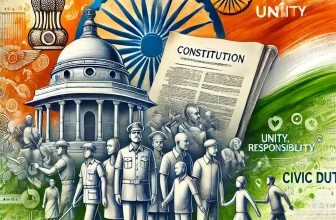The Indian Parliament is the heart of democracy in India, shaping laws, policies, and governance that affect over 1.4 billion people. But for many, how Parliament actually works remains a mystery.
How are laws made? What is the difference between Lok Sabha and Rajya Sabha? How does Parliament control the government? If you’ve ever wondered about these questions, you’re not alone!
This beginner-friendly guide breaks down the Indian Parliament into 10 simple steps, explaining its structure, functions, law-making process, and key roles—so you can understand how the nation’s most important institution operates.
1. Structure of the Indian Parliament
India follows a bicameral parliamentary system, meaning Parliament consists of two houses:
- Lok Sabha (House of the People) – The lower house, where members are directly elected by the people through general elections.
- Rajya Sabha (Council of States) – The upper house, where members are elected by State Legislative Assemblies and nominated by the President.
- The President of India is an essential part of Parliament and plays a key role in the legislative process.
Source: https://www.india.gov.in/my-government/indian-parliament
2. Composition and Membership of Lok Sabha & Rajya Sabha
Lok Sabha (Lower House)
- Total Seats: Maximum 552 members.
- Elected Members: 530 from states and 20 from Union Territories.
- Nominated Members: The President can nominate 2 members from the Anglo-Indian community if not adequately represented (this provision was removed by the 104th Constitutional Amendment in 2019).
- Term Duration: 5 years, but it may be dissolved earlier by the President upon the Prime Minister’s request.
- https://sansad.in/ls
Rajya Sabha (Upper House)
- Total Seats: Maximum 250 members.
- Elected Members: 238 members are elected by State Legislative Assemblies and Union Territories.
- Nominated Members: The President nominates 12 members for their expertise in science, art, literature, and social service.
- Term Duration: Permanent house (not subject to dissolution); one-third of members retire every 2 years.
- https://sansad.in/rs
3. Functions of the Indian Parliament
The Indian Parliament has several key functions, including:
- Legislative Function: Creating, amending, or repealing laws.
- Executive Oversight: Monitoring and holding the government accountable.
- Financial Control: Approving budgets, taxation, and government spending.
- Electoral Function: Electing the President and Vice-President of India.
- Judicial Function: Impeaching the President, judges, and other officials.
4. Sessions of Parliament
Parliament meets in three sessions each year:
- Budget Session (February – May) – The most important session, where the Union Budget is presented and debated.
- Monsoon Session (July – September) – Focuses on general legislation.
- Winter Session (November – December) – Addresses urgent matters and bills.
The President of India summons Parliament, and sessions can be extended or shortened based on government needs.
5. How a Bill Becomes a Law in India
A Bill is a draft of a proposed law. It must go through several stages before becoming a law:
Step 1: Introduction of a Bill
- Types of Bills:
- Ordinary Bill: Any subject except money and constitutional matters.
- Money Bill: Deals only with taxation, public expenditure, and financial matters.
- Financial Bill: Contains financial provisions but is not exclusively a Money Bill.
- Constitutional Amendment Bill: Amends or modifies the Constitution.
Source: https://legislative.gov.in/
Step 2: Three Readings in Parliament
- First Reading – The Bill is introduced in either house. No discussion.
- Second Reading –
- General discussion.
- Sent to a Parliamentary Committee for detailed review.
- Amendments may be proposed.
- Third Reading – The final version of the Bill is voted on.
Step 3: Approval in the Other House
- After passing in one house, the Bill moves to the other house for approval.
- If rejected or modified, both houses negotiate changes.
Step 4: President’s Assent
- Once both houses approve, the President must sign the Bill for it to become a law.
- The President can:
- Approve the Bill → It becomes law.
- Return it for reconsideration (except Money Bills).
- Withhold approval (used rarely).
Source: https://www.india.gov.in/my-government/constitution-india
6. Joint Session of Parliament – Resolving Disagreements
- If Lok Sabha and Rajya Sabha cannot agree on a Bill, the President calls a Joint Session (Article 108 of the Constitution).
- Both houses meet together to resolve disputes.
- Presided over by the Speaker of the Lok Sabha.
- https://sansad.in/poi
7. Parliamentary Committees
Parliament uses committees to examine Bills and government policies.
- Standing Committees: Permanent committees (e.g., Public Accounts Committee).
- Select Committees: Formed for specific Bills.
- Joint Committees: Members from both houses review legislation.
8. Powers of the Indian Parliament
a. Legislative Powers
- Makes laws for the entire country.
- Can amend constitutional provisions.
b. Executive Powers
- Votes of No Confidence can remove the government.
- Ministers must answer questions from MPs.
c. Judicial Powers
- Impeachment of President, Vice-President, and Judges.
d. Financial Powers
- Passes Union Budget and approves government expenses.
Source: https://mpa.gov.in/
9. Role of the Speaker of Lok Sabha & Chairman of Rajya Sabha
- Speaker of Lok Sabha:
- Elected by Lok Sabha members.
- Maintains discipline and order in debates.
- Decides if a Bill is a Money Bill.
- Chairman of Rajya Sabha:
- The Vice-President of India acts as Chairman.
- Presides over Rajya Sabha sessions.
10. Summary – Why Understanding Parliament Matters
The Indian Parliament is the foundation of democracy, responsible for making laws, overseeing the government, approving budgets, and representing the people. It consists of Lok Sabha, Rajya Sabha, and the President, working together to govern the country.
This article explains Parliament’s key functions in 10 simple steps, from how laws are made to how MPs hold the government accountable. Whether you’re a student, voter, or just curious about how India is governed, this guide will help you understand the inner workings of Parliament in an easy-to-follow way.





